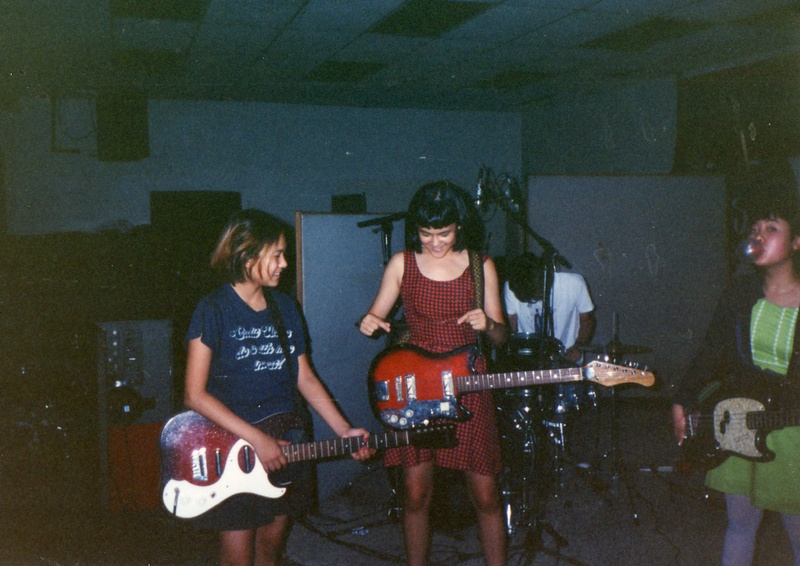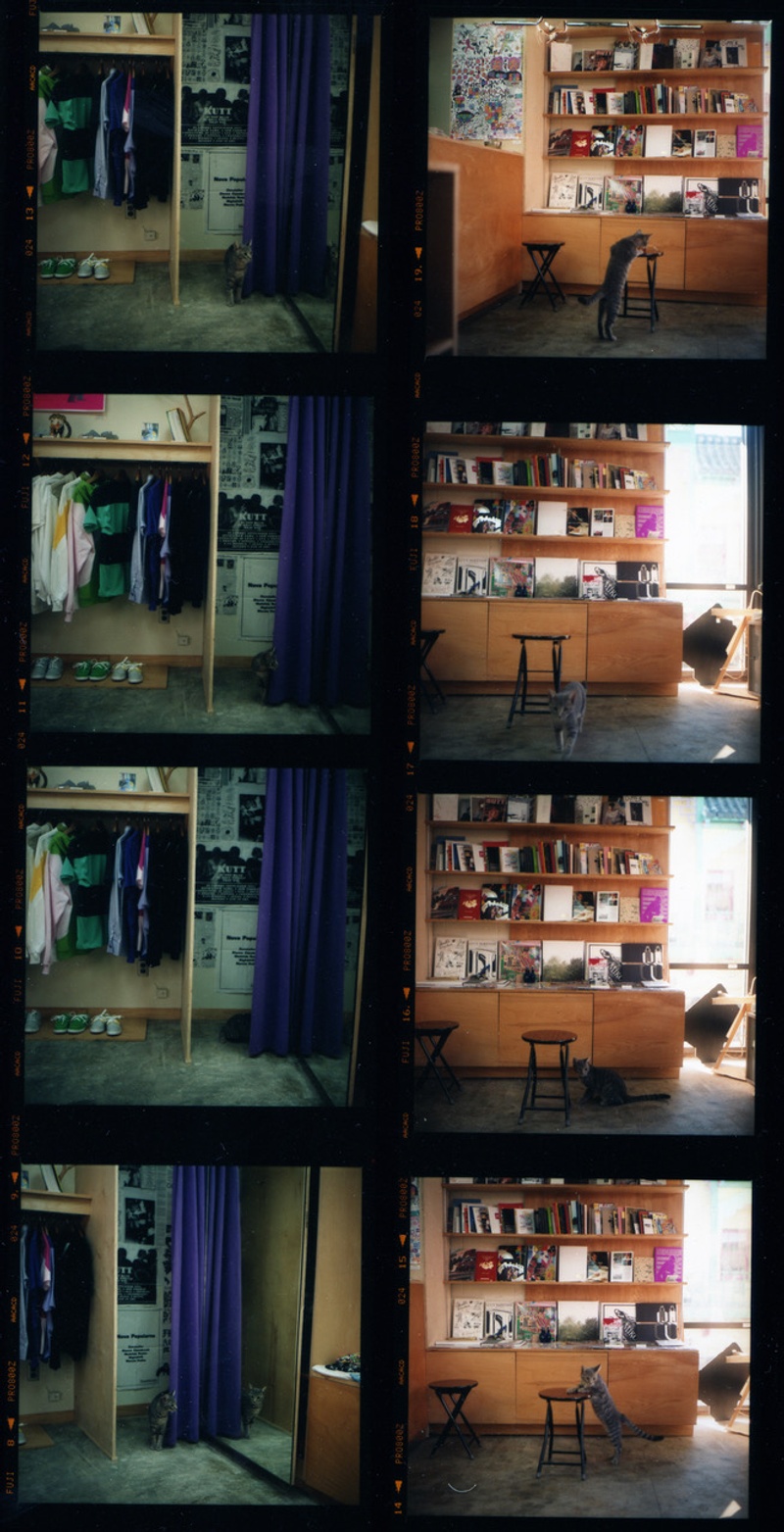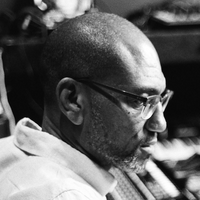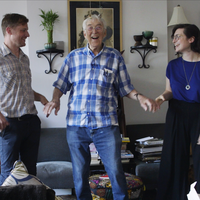On channeling your artistic enthusiasm into flexible forms
Prelude
Wendy Yao has dedicated her energy to championing the output of her creative community. With a DIY-spirit sparked by punk rock and riot grrrl, Yao formed Emily’s Sassy Lime with her sister Amy and friend Emily Ryan. The trio forged a sound born from their Asian American suburban teenage lives. Wendy’s Ooga Booga project was inspired by the networks of thoughtful exchange she experienced during her years as a touring musician. Ooga Booga’s postage stamp-sized storefront existed in Los Angeles’ Chinatown for 15 years with a selection of mix-tapes, zines, clothing, and other artist-crafted goods. The shop often expanded past its tiny physical confines hosting film screenings, music performances, and art shows, and for several years operated a second outpost within the large-scale L.A. art space 356 Mission. With the storefronts now shuttered, Yao is expressing Ooga Booga in even more flexible forms with pop-ups and a web presence.
Conversation
On channeling your artistic enthusiasm into flexible forms
Creator and curator Wendy Yao on the evolution of her creative space, Ooga Booga, what punk rock and DIY culture can teach you, and learning how to set healthy boundaries for yourself.
As told to Mark "Frosty" McNeill, 2863 words.
Tags: Art, Music, Curation, Beginnings, Inspiration, Business, Creative anxiety, Multi-tasking, Mental health.
When did you first get turned on to the DIY spirit and how did that influence you?
I learned about DIY as a concept as I started to learn about punk rock. I was about 13 when I was starting to encounter and unearth the different layers of the culture. It resonated a lot. Maybe it was growing up in an immigrant family. There’s already a lot of values from that, that resonate in terms of improvisational daily practices and resourcefulness—being creative and making the most of what you have, utilizing community in a certain way to make things happen, and not feeling like what’s already out there structurally in the world is completely speaking to you. If you want something to happen that relates to you, you have to create it yourself or bring together the community that works for you. It resonated in that aspect. There were a lot of things about my upbringing where when I discovered underground music, punk, feminism—the concepts as they were articulated were new, but there was something already within me, and the values resonated and struck a deep chord. Suddenly the world made more sense.
It makes a lot of sense. Something you’re already carrying with you is evolving as part of a larger external community. Was there a definitive epiphany that helped you realize that sort of spirit on a more public or community level was important? That you also wanted to become a participant?
We were in elementary school when my sister, who’s a year older than me, came home from school and was like, “I just learned about the ozone layer and the environment.” And she told me about it and I was like, “Oh my gosh. We have to do something!” So we made a zine without knowing what a zine was. Information like, “News alert, this is the ozone layer. This is happening to it.” We collaged pictures and drew some things and whatever, and then we folded it in half and made a little newsletter, and we walked around the neighborhood putting them in everyone’s mailboxes. Again, with no reference to zine making.
I feel like that impetus was already in us, like, “If there’s something we care about, let’s participate. Let’s figure out how to make that happen.” Our parents, it wasn’t in their values to get us very much in terms of toys—we had hand-me-downs. So we often made games out of whatever was there. Literally, we’d just play in the dirt, with sticks and rocks on a hillside for hours, and make a big project like, “We’re going to carve a sofa into this hillside and spend the whole summer doing it and make a little cubby for the cat to hang out in.” I don’t know if that’s really DIY, but it was making your own entertainment or engagement with your community out of what you can manage to access.
Absolutely, you’re working with the materials that are there. What about the interaction with sound and music? Can you talk about the genesis of Emily’s Sassy Lime and how that also might have coincided with something larger outside of the music itself, like zine culture?
Definitely, I think part of it was the early stages of trying to find and connect with people—subconsciously building chosen family. When you’re growing up, entering adolescence and stuff, for many different reasons you have these voids that you’re trying to fill. You want to connect with people who have life experiences that might resonate, who can understand you. Most of us who gravitate towards music at this age might feel like for some reason you’re kind of an outsider. You’re trying to find the people who actually speak your language.

Eventually we were in a band. The band was me, my sister, and our best friend, Emily. I’d spend my time in the library a lot and there was a girl who would sometimes talk to me when I was sitting there reading. She would ask me questions and then she’d be like, “You remind me of my friend, Emily. You should meet.” And then one day, maybe a few months later, me and my sister were going to a frozen yogurt shop and the girl behind us was short by like 50 cents and asked if she could borrow it. I talked to her for a second and realized that she was the Emily I had been hearing about from the library and we were like, “Oh, you’re Emily.” We exchanged information, hung out a little bit, and then started going to see bands together. Bikini Kill played an all-ages show at UC Irvine. We all went together. Things like that were inspiring in terms of thinking about starting a band. Bikini Kill really set up the way that they interacted with the public in a way to inspire people to start their own bands—inspire girls like us to feel like it wasn’t an impossible endeavor, even if, like us, you didn’t have instruments or parents who said you were allowed to be in a band.
A few months after that, Bratmobile played at Jabberjaw and we were going to go with a friend and her dad was going to give us a ride but when he took us there he freaked out and was and was like, “I can’t believe you’re going to this.” Parental fears kicked in and he called our mom and then we were banned from going to Jabberjaw for the rest of our lives—banned from going to shows at all. I guess we just snuck out a lot more after that. That was freshman year and we continued to go to Jabberjaw several times a week for the rest of high school.
Do you remember trying to make a case to your parents at that time as far as the validity of the space or the importance of being involved?
I can’t remember specifically. I mean, my parents had just recently split up and so there were a lot of destabilizing factors going on in the household, so I don’t remember the communication being super rational and clear. I remember at one point we had lunch with our older cousin, who was in college, and my mom was telling him, “You know these girls are so bad. They’re going out to see concerts all the time. What do you think about this?” He was an engineering major, so he asked, “How many hours is a concert outing? How many times a week?” And then quickly, he’s like, “Sounds like it’s less than .3% of their year being spent doing this.” He did this math magic on how many minutes are in a year or something and he was like, “It doesn’t seem like it’s a problem.” And she’s like, “Hmm, okay.” But still for the most part we would just have a classmate cover and say we were going to a study session and then just hitch a ride from a different person to go see a band or something.
Did you feel like there was something important, once you formed a band, to pass along spirit-wise since you’d received encouragement from Bikini Kill and Bratmobile?
Well for us, I would say part of it was just a way to hang out and have fun as three best friends. We didn’t live in the same city, actually. When we met, we were living in the same city briefly and then me and my sister’s parents split up and we moved to San Fernando Valley while Emily was living in Orange County. We weren’t old enough to drive and there was a lot of distance. We would write each other physical letters and send packages multiple times a week. We would call each other—it was back in the day of landlines only and physical tape answering machines. We were living with our grandparents, uncle, aunt, cousins—in a house with a lot of people, and somebody had a fax machine. And so there was this whole sneaky system of ringing the fax machine twice, hanging up, and then we would know it was a friend of ours. We called it the sneaky line and we would talk that way. If one of us wrote a song part, we would call and leave it as an answering machine message, so the other person could play along to it, to write their part. When we’d get together on a rare occasion, if we didn’t have drums, instead we’d use chopsticks and put rice in a little Tupperware and shake it, and a stapler. We’d practice the drums like that.
If you’re leaving the house with a pair of chopsticks or some rice in a Tupperware, it’s easier to slide by undercover.
We look like really good kids, yeah. So it was a lot of makeshift situations, but to be honest, it’s not like, “Poor me, I had to make my own.” It was like, “Whoa, this is even more fun. I have a challenge. I have to figure out the solution to it.” Being sneaky when you’re 15 is really fun. So it wasn’t like, “Oh, it’s so sad that our parents didn’t let us be in a band.” It was kind of like, “Oh, let’s figure out how to hang out with each other and do this thing anyway.”
Having fun was enough. It wasn’t like, “I can’t wait to be a band and rule the world and make a million dollars and be famous,” or whatever it’s supposed to be. I was just kind of like, “I can’t wait to participate in this community and enjoy playing music, being together, making jokes, while having this ridiculous challenge of figuring out how to have a band while you’re not supposed to have a band.” I would say the process and participation was enough. That was what was fulfilling for me.
Can you tell us a bit about Ooga Booga and how you created a space different from a typical store?
Part of it’s just not knowing what you’re doing, but being okay with that. Same with being a band, the kind of DIY-thing. That’s always been the situation for me. In retrospect, my life would have probably been easier if I had come from some big retail experience and learned some of the most basic structure and routines of running a store to make it a little more functional. Instead, I was pointlessly reinventing the wheel all the time.
Usually that’s where innovation comes from, because you’re formulating and learning as you go along.
Yeah, I don’t know if I ended up with that, but I definitely approached it with an open mind and without too many preconceptions about what a store has to be. I was just trying to keep it fluid.
What was that first seed of an idea and how did it come about?
Being part of the music scene you really get exposed to this idea of community as a network that is co-supporting. In the punk scene, it doesn’t feel like a huge hierarchy between the performer, audience, label, venue, record store, and zine distro. There is this true feeling of interconnectedness, that we are all supporting each other to allow this scene to exist. Participation is key and if you care about something you love, you want to support it in those ways. Arts and culture were lifelines when you had a difficult childhood, a difficult adolescence. It meant so much to me to find a connection and discover new things. It sounds dramatic, but it’s life saving to discover the arts if you’re the kind of person that’s inclined to be touched by it.
I felt really lucky to have exposure to so many interesting people. I wanted to have a more public platform to share that with the world. I was interested in having a place for things that at the time didn’t feel like they belonged in a store. Maybe because they were too amateurish. Like with art books, I was interested in the books that were weird, thin, and floppy. I was interested in all these other things that we often exchange by hand. Also, I wanted to give artists a chance to put out things that are supposed to be more like side-conversation objects. Because when you have a gallery show you’re making these monumental statements. I wanted a space for the non-monumental output. Because people every day are doing random little things that are creative and I feel like there’s a lot of conversations to be had outside of the big statements, the finished thing on the pedestal, or whatever. A lot of the lifeblood of the creative community happens within the interstitial objects and conversations. And so through these objects, they were kind of almost stand-ins for conversations that would interact with the public.
The Ooga Booga store in Chinatown was very small but you did lots of public programming above and beyond the typical retail mission. Why was it important for you to do more?
Probably because I’m insane. After 15 years of doing the store I’m like, “Wow, that was a lot of work and I’m really exhausted.” A lot of it came out of just trying to move through the whole thing very organically, out of my curiosity and passion for things in this realm. I just get excited to share—not just music, not just art, not just one group of musicians, or one type of artist. There’s so many different layers to it. It’s constantly shifting, like this vague, expansive organism that’s really three-dimensional. Programming events and performances just seems to factor naturally into that.
My store was only 300 square feet, but we were lucky enough to be able to use the surrounding parts of the building to have people congregate and perform. It was amazing to make public, cultural spaces appear for just hours and then disappear again. Suddenly, this courtyard or balcony becomes a venue, and then it evaporates again. It doesn’t exist without the whole community that helps make it happen. It was a huge privilege to have been able to do those things, even if it was a ton of work.

How do you feel about having recently shuttered the store front? You poured your heart and soul into it, but it’s powerful to know when to make a change. Can you talk a bit about the letting go of the physical space?
It was a super hard decision to make because my instinct is always to say yes to everything. I’ve lived a lifetime of being stretched too thin and biting off way more than I could chew and as a result, dropping lots of balls. Since having a child, it really exponentially magnified and also put a hard stop on what my limits really were, because you really have to prioritize that. I had to make the decision to set my own limits on what I could manage as a person. Something had to give, but it was a decision I didn’t want to make and I was really sad about it. Part of it was thinking about what I really need and trusting that will be okay.
Ooga Booga was always meant to be a very flexible and portable project. I was into occupying a very small footprint, and then expanding and contracting as needed for different projects. Sometimes I would travel far and bring the project in my suitcase. Sometimes I would expand into the whole building’s courtyard and then shrink back into my store. Right now, Ooga Booga is not totally gone. It’s a web shop and we have a pop-up store. So we’re in this even more portable phase. It comes a lot more naturally to me.
How has becoming a parent changed the way you approach your work?
Well, hopefully it’s healthier. You can’t be a good parent unless you are taking care of yourself. I’ve definitely learned so much about being a human, even if it’s just setting limits. You really have to practice that with your child and it reverberates to the other parts of your life. The phrase that comes to my head daily at this point as a parent comes from high school, when you’re taking a test and it’s done, they go, “Pencils up.” Every single day when it’s time to pick him up, no matter what you’re doing, it’s pencils up. Before, I was bad with boundaries and would just let myself give so much beyond what was good for me. So having that kind of “pencils up” is teaching me to be a little bit more structured and more healthy.
Wendy Yao Recommends:
1) A&J Restaurant in Irvine
2) C♥️QUETA
3) Alake Shilling
4) Griffith Park
5) Misa Chhan
- Name
- Wendy Yao
- Vocation
- Artist, Curator, Professional fan of people and things
Some Things
Pagination



